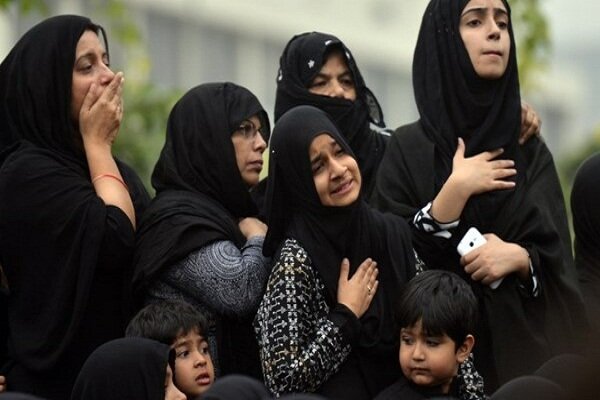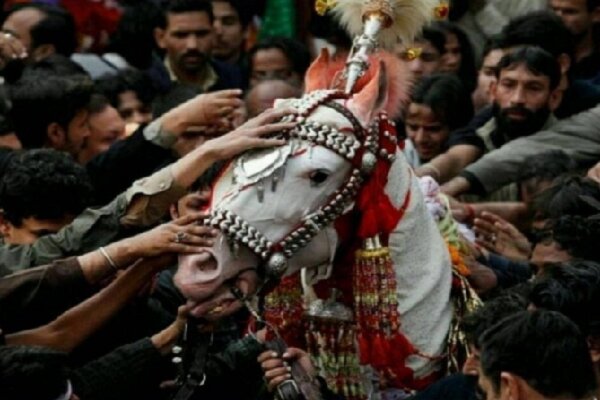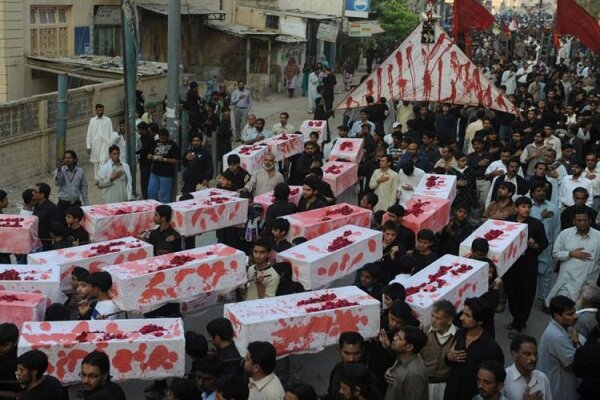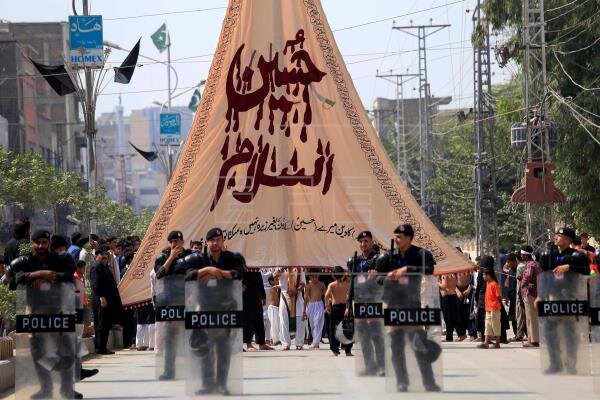Muharram in Pakistan: from the symbolic ceremony of “Zul-Janah” to the ship “Safina Al-Najat”

Mehr News Agency, International Group, Elnaz Rahmatnejad: All walks of life The people of Pakistan, with its population of 200 million people, have a special interest in holding the mourning ceremony of the first decade of the month of Muharram as grandly as possible. The people most similar to Iran in celebrating the month of Muharram are the Pakistanis, and in every neighborhood and alley, a hosseiniyeh and taekya are set up.
During these days, Shiites mourn with the speeches of scholars, beating their breasts, chanting laments, and wearing chains, but in the mosques and schools of the Sunnis, during the days of Tasu’a and Ashura, there are speeches and cooking of offerings for They have distribution in neighborhoods and among poor people in their programs.
At the same time with the arrival of Muharram 1446, we started to introduce mourning habits and customs in different neighboring countries.
The first part of this report, which is dedicated to mourning habits and customs in Lebanon, can be read and reviewed in the following link:
* « Muharram in Lebanon; From the ceremony of Hezbollah’s shrine in Dahiya to reciting prayers in Nabatieh
In the following, we read the detailed second part of this case, which deals with mourning habits and customs in Pakistan;
Pakistan’s spiritual atmosphere in the month of Muharram
Pakistan’s Shiites wear black clothes, turn off the lights in their homes and do not use bedding when sleeping. Also, the cooking of food is closed, especially in Sadat’s house, and most people participate in mourning ceremonies from morning to evening.
Leaving the dishes and turning off the cooking stove until the end of the month of Muharram is one of the other common customs of the people of Pakistan, especially the villagers in this month. During these days, men avoid shaving and wearing new clothes, and women avoid makeup and use jewelry such as earrings and bracelets.
It is customary among people that no one laughs in this month, and if someone laughs out loud, he is warned to avoid such laughter in the month of Muharram. The 9th and 10th of Muharram, which coincides with Tasua and Ashura, are official holidays. In addition, lectures, reciting prayers, breast-feeding, Taswa and Ashura are among the events of these days in Pakistan. Decorating the knowledge of Hazrat Abbas (pbuh), making a replica of the shrine of Imam Hussain (pbuh), making the coffins of the martyrs of Karbala, and decorating the zuljanah of the horse of Imam Hussain (pbuh) for the mourning delegations are among the customs of the people of Pakistan in mourning the martyrs.
Sunni marketers also set up salawati stations in front of their stores and commercial places during the days of Tasua and Ashura and give cold water, syrup and tea to mourners and ordinary people. Television channels, especially Pakistan’s national network, also broadcast mourning ceremonies and speeches by Shia and Sunni scholars regarding the philosophy of martyrdom of Imam Hussain, Ahl al-Bayt (AS) and his companions from 1st to 11th of Muharram. Broadcasting of music on all public and private networks is interrupted during the days of Taswa and Ashura, and in this way a special spiritual atmosphere prevails in Pakistani society.
“Mourning” in Imam Bargah
Pakistani Shiites keep alive the memory of the uprising of Imam Hussain (AS). Breastfeeding ceremony is held in Pakistan which is called “mourning”. This ceremony is usually held in places called Imam Bargah, which is almost equivalent to Hasina in Iran and Iraq. The largest presence of Shiites is in the southern regions of Pakistan and cities such as Karachi and Rawalpindi. In addition to the chest-shaking ceremony, the ceremony of carrying ta’ziyeh (carrying a replica of the martyrs of Karbala and Imam Hussain’s court) is also held in different regions of Pakistan.
Hosseini Irani in Pakistan
In the city of Karachi, Pakistan, there is a Hosseinieh named after the Iranians, and Iranians have a strong presence in this Hosseinieh to mourn the month of Muharram. This Hosseinieh was established by some Yazidis living in Pakistan and it has a long history, and usually on the days of Ashura and Tasu’a, a large crowd goes to this Hosseinieh in the form of wearing chests and chains.
Zul-Janah ceremony; The symbol of the victory of right over wrong
Sultan Mohammad, who has been serving for many years in one of the Hussainiyas in Karachi, said: “We have many ceremonies, but there are some ceremonies that people always observe because of their beliefs. They set up One of these ceremonies is the “Zul-Janah” ceremony, which is held symbolically every year and is an important part of the Ashura ceremony in Pakistan.
In the procession that takes place on the day of Ashura, each group of mourners carries Zul-Janahi. People have a lot of faith in this ceremony and especially for this purpose they buy a foal that has not been used for transportation and take care of it in a special place like a baby. does not have. This animal is used two or three times a year; For the first time on the day of Ashura, the animal is decorated with beautiful and precious fabrics and dressed in red as a sign of mourning. People kiss it with the belief that their needs will be answered and ask for their needs from Dhul-Janah. This ceremony is very important for Maram. They consider Dhul-Janah to be a symbol of clarity and the victory of truth over falsehood.”
Marking, a means of intercession
Sultan Mohammad continued his talk about “Alamkashi” and said: “Shiites in Pakistan have a lot of devotion to science and they consider science as a means of their intercession and they respect science with respect and devotion. They touch and kiss it. We have many families in Karachi who have received relief by appealing to Imam Hussain (a.s.) and have prepared hundreds of “alms for the Muharram ceremony and deliver them to the Hussainiyyas to be used in the Muharram mourning ceremony.”
mustache; Remembering the thirsty lips of Imam Hussain (AS)
This Khadim Hussain of Karachi said: “This tradition is not very old, but it was done by one person and now it is done almost everywhere. In every alley you pass, you can see a place that we call “mustache” in Pakistan and I think it’s called Saqaqhana in Iran. In this place, syrup and cool water are prepared for the mourners in memory of the thirsty lips of Imam Hossein (a.s.) and his companions, and for several years, people have been offering offerings other than water and syrup to the mourners in these mustaches.”
Building the rescue ship; Lifeboat
One of the other traditions of the people of Pakistan during Muharram, which is more common among the Shiites of Karachi, Matan and Lahore, is the construction of a ship, which is known as “Safinah Al-Najat”.
In the days of Muharram, the Shiites of Pakistan, referring to the hadith of the Prophet of Islam (PBUH), who introduced Imam Hussain as a “ship of salvation”, build a small ship in front of the entrance of the Hosseiniyeh, and a black flag decorated with the blessed names of the Ahl al-Bayt (PBUH) and the same They install the hadith of the Prophet (PBUH) on it. People consider this ship to be similar to Noah’s savior ship and pray for it, kiss it and cry next to it.
The content of the funeral of the martyrs
From the 1st day of Muharram to the 10th day of this month, mourning ceremonies and gatherings are held in Hosseiniyehs of this country. During this period, the scholars and the dhikreen, every night, tell the people a part of the martyrdom travel plans of Imam Hussain (a.s.) and his companions in the following order, which is explained below;
The first night: The movement of Imam Hussain (AS) to participate in the Hajj ceremony and not completing it
The second night: Departure of Imam Hussain (AS) and his companions from Mecca to Karbala
Third night: Fatemeh Soghari (pbuh) daughter of Imam Hussein (pbuh) was separated from the family
The fourth night: Martyrdom of the sons of Muslim bin Aqeel (AS)
The fifth night: Har’s encounter with Imam Hussain (AS) and the martyrdom of Har and Qasim bin Al-Hassan (AS)
The sixth night: The life and martyrdom of Hazrat Ali Akbar (AS)
The seventh night: The life and martyrdom of Abul Fazl al-Abbas (AS)
The eighth night: the life and martyrdom of Ali Asghar (AS)
Ninth night: (Tasua) Har Riahi joining the companions of Imam Hussain (AS)
Tenth night: (Ashura) Martyrdom of Imam Hossein (AS)
Formation of a committee of Sunni and Shiite leaders
The biggest problem of Shias in Pakistan is security issues. Due to the influence of extremist ideas in Pakistan, Shia Muslims face many risks during the Muharram mourning ceremony. Sectarian violence against Pakistani Shias and Hazara Shias is prevalent. Despite all this, the Shiites of Pakistan prepare for the mourning ceremony every year amid strict security measures. High-ranking police officers of all small and large cities across the country are reviewing security plans for the protection of mourners a few days before Muharram. In an unwritten custom, the Sunni scholars visit the mosques and shrines of the Shiites a few days before Muharram and have a conversation with the Shiite scholars.
The lovers of Seyyed al-Shahda (AS) in Pakistan, apart from any threats, mourn and want to die with the memory and name of Imam Hussain (AS). In the four states of Pakistan, a committee consisting of Sunni and Shia leaders has been formed to coordinate the security forces to hold Muharram without incident.







